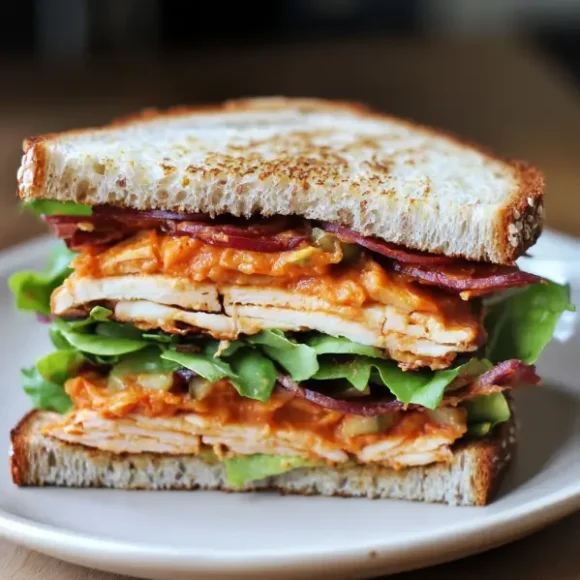Understanding Gluten-Free Diets
Gluten Free Sandwich options are an essential part of a gluten-free diet, especially for those managing gluten sensitivity or wheat allergies. It’s also a popular choice for individuals seeking to improve digestion or overall health. To stick to a gluten-free diet, it’s important to:
- Learn to spot hidden gluten in processed foods like sauces and soups, ensuring that your Gluten Free Sandwich stays safe.
- Focus on naturally gluten-free foods, including fruits, vegetables, and lean proteins, which pair well with your Gluten Free Sandwich.
- Use gluten-free substitutes for everyday items like bread and pasta to make sure your Gluten Free Sandwich is not only tasty but also health-conscious.
While a Gluten Free Sandwich may seem restrictive at first, with a little practice, it becomes much easier to prepare. There are plenty of delicious options to choose from, and the benefits for those who need it are well worth the effort. Embrace creative fillings and gluten-free bread options, and enjoy the variety of Gluten Free Sandwich possibilities to suit your taste and dietary needs.
Find delicious gluten-free recipes for every occasion.
Why Choose Gluten-Free Sandwiches?
When it comes to convenience, Gluten Free Sandwiches are an excellent choice. Whether for lunch, a snack, or a picnic, Gluten Free Sandwiches are versatile, satisfying, and easy to enjoy. But why specifically choose a Gluten Free Sandwich?
Here are some reasons:
- They’re essential for anyone avoiding gluten due to health issues like celiac disease or gluten intolerance, making the Gluten Free Sandwich an ideal option for those with dietary restrictions.
- Gluten Free Sandwiches offer variety, with countless gluten-free bread options and fillings to choose from, so you never have to get bored.
- They’re easy to prepare and can be customized to suit different tastes, ensuring that your Gluten Free Sandwich fits perfectly with your preferences.
- Gluten Free Sandwiches guarantee that you don’t have to miss out on a simple pleasure just because of dietary needs, giving you the freedom to enjoy your meal without compromise.
Discover how to make your meals healthier.
Types of Gluten-Free Breads for Sandwiches
The type of bread you use is key to creating a great gluten-free sandwich. Thankfully, there are many options available now, each with its own flavor and texture.
Some popular choices include:

Rice-based breads: These are light and have a mild taste that pairs well with most fillings.
Almond or nut-flour breads: These are denser and perfect for those wanting a richer flavor and extra protein.
Tapioca or potato flour breads: They’re soft and chewy, making them a favorite for sandwiches.
Seed-based breads: Packed with nutrition, they’re hearty and flavorful.
When picking gluten-free bread, check for labels that confirm it’s truly gluten-free. Some brands use shared facilities, which can cause contamination.
Find recipes that make gluten-free dining fun.
How to Make a Perfect Sandwich without gluten
Creating the perfect gluten-free sandwich might seem tricky, but it’s actually simple with a few tips. Here’s how to get it right every time:

Pick the right bread: The texture of gluten-free bread can vary, so choose one that suits your filling.
Toast for structure: Gluten-free bread is often softer than regular bread, and toasting helps keep it sturdy.
Layer smartly: Spread hummus, avocado, or mayonnaise on the bread to prevent it from getting dry.
Add a balance of flavors: Combine proteins, veggies, and condiments to make it flavorful.
Avoid sogginess: Pack juicy ingredients like tomatoes separately if you’re making the sandwich ahead of time.
With a little care, your gluten-free sandwich will be delicious and satisfying.
Popular Gluten-Free Sandwich Recipes
Looking for ideas? Here are some gluten-free sandwich recipes that are easy to make and packed with flavor:
- Turkey and Avocado Club: Toasted gluten-free bread with turkey, avocado, crispy bacon, lettuce, and a light mayo spread.
- Caprese Sandwich: Gluten-free focaccia topped with fresh mozzarella, juicy tomatoes, basil, and a drizzle of balsamic glaze.
- Veggie Delight: Roasted zucchini, red peppers, and eggplant layered with hummus on gluten-free seed bread.
These recipes are flexible, so feel free to swap out ingredients to match your preferences.
Avoiding Cross-Contamination in Preparation
Cross-contamination is a serious concern for those following a strict gluten-free diet. Even a small amount of gluten can cause problems for someone with celiac disease. To stay safe, here are some precautions to take:
- Use separate tools: Have dedicated cutting boards, knives, and utensils for gluten-free cooking.
- Clean thoroughly: Wash surfaces, tools, and hands after handling gluten-containing items.
- Store separately: Keep gluten-free ingredients in their own containers, away from other foods.
- Label items clearly: Mark gluten-free items to avoid mix-ups.
By being mindful, you can enjoy your gluten-free sandwich without worry.
Dining Out: Finding Gluten-Free Sandwich Options
Eating out can feel challenging on a gluten-free diet, but it’s definitely possible. You just need to plan ahead and ask the right questions. Here are some tips:
- Research restaurants: Look online for places with gluten-free menus or reviews mentioning gluten-free options.
- Ask about preparation: Make sure the staff knows to avoid cross-contamination when preparing your meal.
- Choose simple options: Stick to sandwiches with basic, naturally gluten-free fillings like grilled chicken or fresh vegetables.
- Be specific: Don’t hesitate to explain your needs so that your food is prepared safely.
Dining out doesn’t have to be stressful. With a little effort, you can still enjoy a gluten-free sandwich on the go.
For Special Occasions
Special occasions call for creative gluten-free sandwich ideas that impress guests and accommodate everyone’s dietary needs. Try these ideas:
- Mini tea sandwiches: Use gluten-free bread and fillings like cucumber, smoked salmon, or egg salad for a fancy touch.
- Sandwich platters: Offer a mix of gluten-free options like sliders, wraps, and open-faced sandwiches for variety.
- Kids’ party sandwiches: Cut gluten-free bread into fun shapes and use classic fillings like peanut butter and jelly.
These options are sure to make any event enjoyable for all guests, gluten-free or not.
Troubleshooting Common Issues with Gluten-Free Sandwiches
Making gluten-free sandwiches can come with challenges, but most are easy to fix:
- Bread falls apart: Use moist spreads like hummus to hold the bread together, or toast it for extra stability.
- Soggy sandwiches: Keep wet ingredients like tomatoes or dressings separate until you’re ready to eat.
- Lack of flavor: Add herbs, spices, or bold spreads to boost taste.
A little trial and error will help you master the art of gluten-free sandwiches.
Gluten-Free Sandwiches for Specific Dietary Needs
A gluten-free diet often intersects with other dietary requirements. Here’s how to adapt your sandwich:
- Dairy-free: Replace cheese with plant-based alternatives or avocado slices.
- Low-carb: Use lettuce leaves, collard greens, or even grilled eggplant slices instead of bread.
- Vegan: Load up on hummus, roasted vegetables, and marinated tofu for protein.
There’s a gluten-free sandwich solution for nearly every dietary preference.
FAQ Section
Can a sandwich be gluten-free?
Yes, a sandwich can absolutely be gluten-free! The key is to use gluten-free bread, which is specially made without wheat, barley, or rye. Many gluten-free bread options are available today, made from ingredients like rice flour, almond flour, or potato flour. Additionally, be sure to choose fillings that are naturally gluten-free, such as meats (e.g., turkey, chicken, or roast beef), cheeses, fresh vegetables, and gluten-free condiments like mustard or mayonnaise. By selecting gluten-free ingredients and avoiding hidden sources of gluten, you can enjoy a delicious and safe sandwich.
What can I use instead of bread for sandwiches?
If you’re looking for alternatives to gluten-free bread, there are several creative options that are both healthy and naturally gluten-free. You can use large lettuce leaves or collard greens as wraps, creating a lighter sandwich with a satisfying crunch. Rice paper or sweet potato slices also serve as great bread substitutes, offering a slightly different texture and taste while remaining gluten-free. These alternatives are perfect for those avoiding gluten and looking for a lower-carb or nutrient-dense option. Experimenting with these alternatives can lead to tasty, gluten-free sandwiches without sacrificing flavor.
Are Subway sandwiches gluten-free?
While some Subway locations offer gluten-free bread, it’s important to be cautious when ordering, as cross-contamination can be a risk. Gluten-free bread is often prepared in the same area as regular bread, and shared utensils or surfaces may introduce gluten into the meal. If you’re sensitive to gluten or have celiac disease, it’s essential to ask the staff about how they prepare the bread and whether they take precautions to avoid cross-contact. Always clarify your dietary needs to ensure your meal is safely prepared.
What do celiacs eat instead of bread?
For individuals with celiac disease, who must strictly avoid gluten, there are various alternatives to traditional bread. Celiacs often use gluten-free bread made from rice flour, almond flour, or other gluten-free ingredients. Additionally, other bread substitutes like rice cakes, lettuce wraps, or gluten-free crackers work well for sandwiches or as a side. Some also enjoy using thin slices of sweet potato or zucchini, grilled to create a unique, gluten-free “bread” for a satisfying meal. With these alternatives, individuals with celiac disease can still enjoy a variety of foods without compromising their health.
CONCLUSION
In conclusion, adopting a gluten-free diet doesn’t mean you have to miss out on the simple pleasures of a delicious Gluten Free Sandwich. With a little creativity, the right ingredients, and careful preparation, Gluten Free Sandwiches can be just as satisfying as traditional ones. From choosing the best Gluten Free Sandwich bread to making sure your meal is free from cross-contamination, the steps to creating the perfect Gluten Free Sandwich are simple yet essential.
Whether you’re catering to health needs like celiac disease or gluten sensitivity, or just looking for a healthier meal option, Gluten Free Sandwiches offer a versatile and enjoyable way to stick to your dietary preferences. The variety of Gluten Free Sandwich breads and fillings available ensures you’ll never run out of delicious options. By experimenting with different fillings and exploring various Gluten Free Sandwich bread alternatives, you can craft flavorful, satisfying Gluten Free Sandwiches for every occasion.
With these tips and ideas in hand, you can confidently embrace the gluten-free lifestyle and enjoy tasty Gluten Free Sandwiches without compromise. There’s no need to sacrifice flavor or convenience when you can make your perfect Gluten Free Sandwich at home or on the go. So, next time you’re craving a sandwich, reach for a Gluten Free Sandwich—it’s a meal that everyone can enjoy, gluten-free or not.


3 thoughts on “10 Irresistible Gluten Free Sandwich Recipes You Need to Try Today”